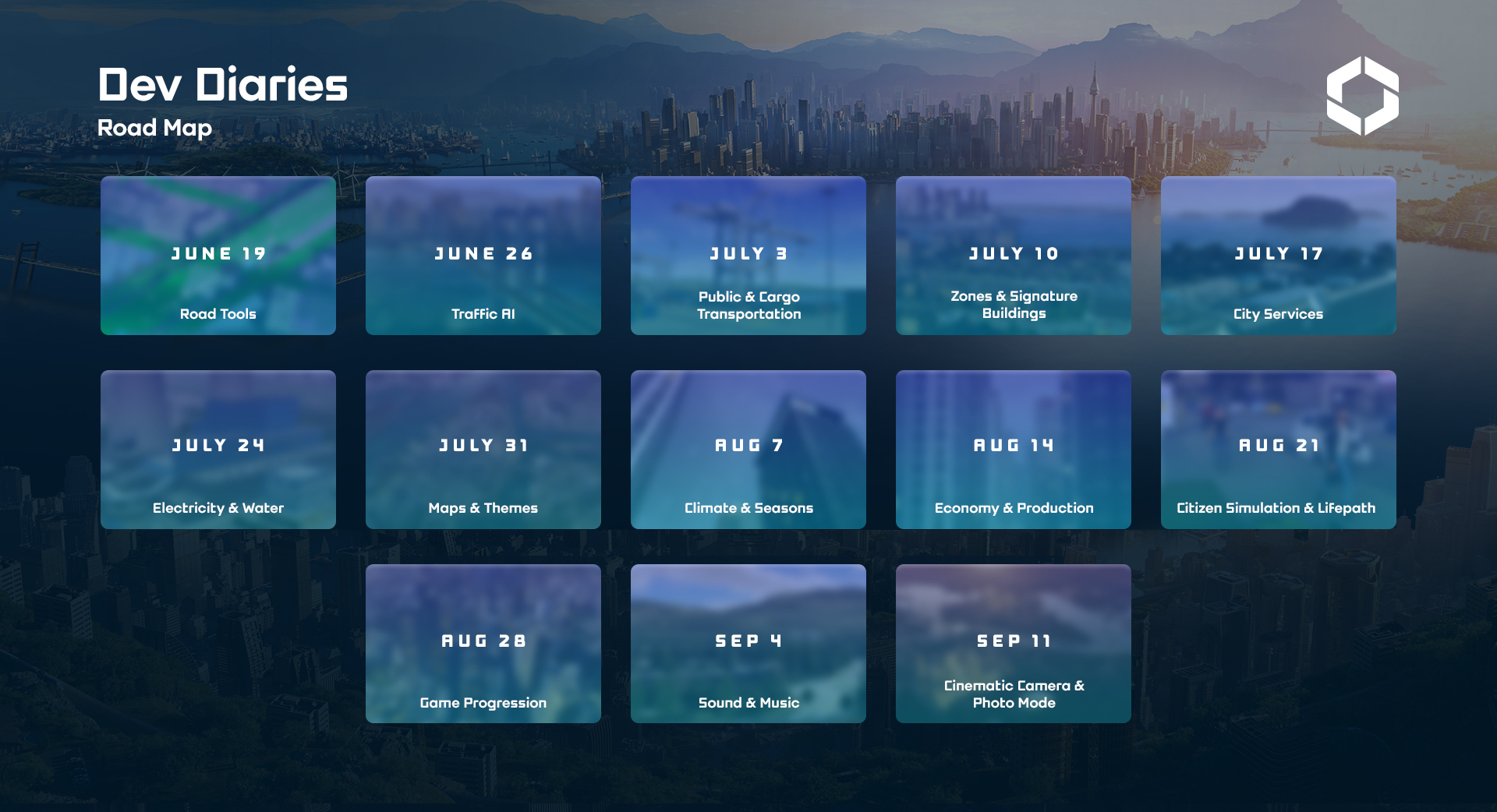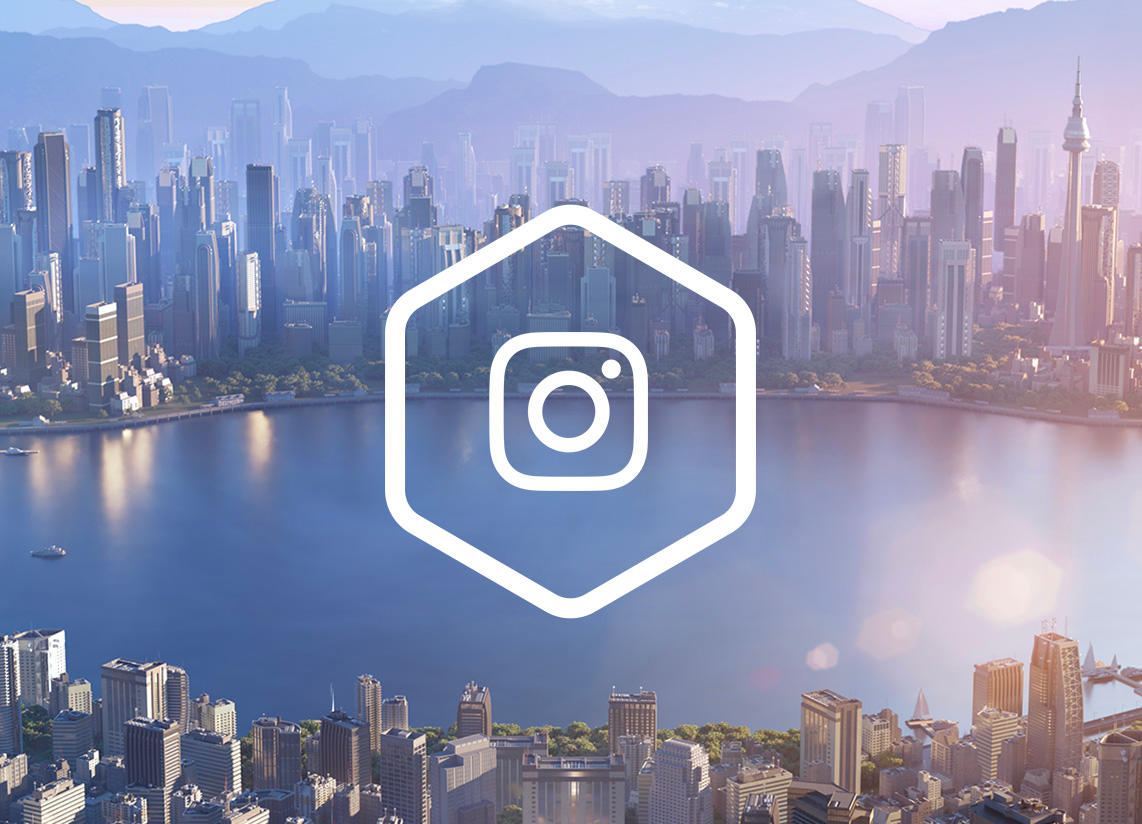Cities: Skylines II Feature Highlight #5: City Services
Hello there city building enthusiasts! It’s time for a new Cities: Skylines II development diary, and this time we are taking a look at the city services available in the game. Brand-new services join the many familiar city services, and while their basic functionality has remained the same, they have more nuanced and complex mechanics befitting a more realistic city-building game. City services can also be restricted to districts, and we will also take a look at the city-management options provided by districts and policies. Districts make governing the city easier with more detailed information available while policies can be assigned to the whole city as well as directly to the districts, allowing fine-tuning of the various areas to make life more enjoyable for the citizens or more profitable for the businesses.
City Services
The basic gameplay of city service remains the same in Cities: Skylines II: Your task is to provide the citizens with various services that increase their quality of life, bring them happiness and keep them safe. However, unlike in the previous game where you wanted to cover the city evenly with all the different service types, the road to the perfect city in Cities: Skylines II lies in understanding the needs of the citizens and fulfilling them by providing suitable services as well as other activities such as places to go shopping. You can, of course, place the various services throughout the city but doing so can be costly and provides only minor additional benefits overall. Where city services directly increased Land Value in the previous game, Cities: Skylines II takes a different approach. City services only indirectly affect Land Value as they answer the needs of citizens and companies in the city, which in turn increases their willingness to pay higher rent in the area, thus increasing their levels and the Land Value. For more information about Land Value check out our previous development diary Zones & Signature Buildings. Furthermore, not all citizens have the same needs. Senior citizens have more free time and value places where they can spend that free time. Families with children on the other hand value areas with schools. Working-age citizens seek residence in areas that have quick connections to workplaces. And companies value services that increase their Efficiency and profit margin. Citizens’ needs can be inspected from their household’s Selected Info Panel (SIP) by hovering over the family’s Happiness icon. Similarly, companies' needs can be inspected in their SIP, hovering over their Efficiency value.
Service Types
Roads form the backbone of the city, providing buildable zones around them, paths for agents to travel on, and the basic infrastructure for water and electricity distribution as the water pipes and electric cables run pre-built under the roads. The condition of roads decreases over time as vehicles travel on them resulting in slower travel speeds and a higher chance of traffic accidents. To keep the roads safe to drive on and the overall road condition high, a Road Maintenance Depot is required. It sends out a fleet of Road Maintenance Vehicles that roam through the city, patching up worn-down asphalt. Roads are discussed more in-depth in another development diary Road Tools.

The Road Maintenance service keeps your roads in good condition and clean up after traffic accidents
Electricity
Electricity is one of the key components in running a city. Most buildings require electricity to function and citizens are not willing to suffer a lack of electricity for long before moving out. Businesses lose most of their efficiency when they are deprived of electricity which causes their production and overall function to cease almost entirely and will eventually lead to them going out of business as they can’t make a profit and pay their bills. Cities: Skylines II features various different power plants from the green, sustainable but quite expensive Wind Turbine, Solar Power Plant, Geothermal Power Plant, and Hydro-electric Power Plant to the raw, polluting power of fossil fuels in the form of Coal Power Plants and Gas Power Plant. Nuclear Power Plant represents the awesome power of the atom, it’s expensive but delivers enough electricity to power up almost any kind of city!

The Gas Power Plant is one of many options to provide your city with electricity
Water & Sewage
Water and sewage provide your citizens with the basic necessities and include both familiar and new options. Lack of fresh water leads to people becoming unhappy while companies' functions are halted as their efficiency decreases greatly. City services also lose much of their effectiveness if they are deprived of fresh water. Similar to in Cities: Skylines Surface water can be pumped from open water sources and the water quality is affected by pollution in the water, caused by sewage sources. Conversely, Groundwater works quite differently in Cities: Skylines II. Unlike in the game’s predecessor, where the groundwater was pumped by placing water towers anywhere on the map, Cities: Skylines II maps feature groundwater deposits full of fresh water. These reservoirs have a limited refreshment rate and are very susceptible to ground pollution, so plan your water supplies accordingly. Sewage treatment is a crucial part of city management. In Cities: Skylines II sewage must be either pumped out of the water network and into open waters through a Sewage Outlet or treated in a Wastewater Treatment Plant where it is purified and pumped back into the freshwater network. The pollutants gathered from the treated wastewater become solid waste which can be hauled to any of the city’s garbage management sites. Both Electricity and Water are discussed in more detail in next week’s development diary Electricity & Water.

Make sure your water pumping services are nowhere near pollution to avoid sick citizens
Healthcare & Deathcare
At their core, both Healthcare and Deathcare are relatively straightforward services and function much like they do in the game’s predecessor. Medical Clinics and Hospitals provide healthcare for the sick and ambulance transportation for those too sick or injured to travel to the medical facilities by themselves. Additionally, healthcare services provide citizens in the surrounding area with a passive Health bonus while ambulances will respond to traffic accidents, taking care of injured citizens and bringing them to a medical clinic or hospital for treatment.

Improve your citizens’ health with the Health Research Institute (left) and provide local healthcare services with a Hospital (right) Deathcare prepares the deceased on their final journey, transporting them to the cemeteries and crematoriums in hearses. Citizens can die of old age, if their Health decreases too much, if they are involved in a traffic accident, or if they are inside a building when it collapses due to being abandoned or affected by a natural disaster.

A cemetery provides citizens with a final resting place and can improve their well-being too Citizen Health is positively affected by the availability of resources the household uses and their consumption as well as the availability of Healthcare. Negative effects on citizen Health are different pollution types, previous illnesses and injuries, and any uncollected garbage. A sick citizen cannot contribute to their workplace and thus affects the company’s efficiency. Therefore it is important to make sure that citizens are healthy and able to contribute to maximize the city’s success!
Garbage Management
Every building accumulates garbage as a by-product of humans living, working, or spending free time there. Various factors can contribute to garbage being accumulated such as: building and zone type, building level and size as well as citizen education level. Higher-level buildings generate less garbage as do citizens with a higher education level. Garbage is handled by building Landfills and other garbage management buildings which tend to pollute their surroundings, with the Incineration Plant pushing out a lot of air pollution as well, so they should be built far away from residential areas and preferably downwind to avoid the air pollution from affecting the city. The facilities send out garbage trucks that collect garbage from buildings and bring it back for processing. Landfills simply store and slowly process the garbage while the Incineration Plant burns it, turning waste into electricity. The Recycling Center separates the usable parts from the garbage and turns them into resources that can be used by manufacturing companies to produce goods and products.

Landfills (right) can take up precious land while recycling centers (left) and incineration plants process garbage faster
Education & Research
Education is an important service for a successful city. You can provide your citizens with education by building various schools that correspond to different age groups. Children always go to Elementary School if one is available, while Teens and Adults have the freedom to choose whether to go to school or switch to working. Teens can go to High School while Adults have the option to either go to College or one of the Universities available in the game. When choosing between school and work, citizens calculate which is financially more beneficial for them: to start working now in a lower position and earning money, or studying for a higher possible position earning them more money. Some citizens also simply choose to study or work depending on their inherent interests.

Provide your citizens with a college education to fill well-educated job openings Citizens have 5 levels of education: Uneducated, Poorly Educated, Educated, Well Educated, and Highly Educated. Every time a citizen graduates from a school, their education level increases by one. Citizens can also fail to graduate at which point they evaluate their options and either continue studying or get a job. Education levels are important when filling job positions in companies and city services as most of them have a certain amount of job positions for the various education levels. If companies can’t fill all open positions with the applicable employees (i.e. not enough workers with high enough education), the service’s efficiency decreases and in the case of companies, their production output is affected negatively. Higher-level companies have more job positions for higher education levels compared to low-level companies and in general, higher-educated employees are more sought after than lower-educated employees. As a special effect, Elementary Schools give a Well-being bonus for families with children living close to the school. This encourages families to move into areas that have Elementary Schools, and can, to some extent, be used to guide how a certain portion of the population behaves.

Encourage families to move into an area by providing them with a local elementary school
Fire & Rescue
Fire & Rescue services are quite straightforward gameplay-wise. Having a Fire House or Fire Station present in the city decreases fire hazards in the area surrounding the service buildings. The fire department sends out fire engines to put out building fires, and as fires can spread quickly it is important to sort out traffic jams so that in the case of an emergency, the fire engines are not stuck behind traffic while trying to reach their destination.

The Fire Station is ready to respond to fires in the city and can be upgraded as your city’s needs increase Firewatch Towers can be placed in the wilderness to keep watch on and lower the risk of forest fires in their surroundings. Forest fires can easily spread and light nearby buildings, so you will need the Firefighting Helicopter Depot to send out their helicopter fleet which can put out both forest fires and building fires.

Build Firewatch Towers and Firefighting Helicopter Depots to combat forest fires Fire & Rescue Service also includes disaster prevention and response. Fire engines rush to rescue citizens trapped in collapsed buildings, while the Early Disaster Warning System detects natural disasters early and sends out notifications to citizens to take shelter. If the city has Emergency Shelters, citizens hurry there and wait out the disaster.

Emergency Shelters provide a safe place for citizens during a disaster while the Early Disaster Warning System notify them of an impending disaster
Police & Administration
Police keep order in the city and their presence, be it Police Stations or the Police Headquarters, decreases crime accumulation in their neighborhoods. Patrolling police cars also encourage citizens to behave well and they decrease crime probability along the roads they travel. Unless limited by selected districts, police cars can patrol the entire city.

The Police Headquarters keep your citizens safe and can detain criminals until they are transferred to a prison Police respond to crimes and attempt to capture the criminal at the crime scene while the crime is in progress. Arrested criminals are put in jail, and some criminals are sentenced to serve prison time. These prisoners are then transported either to a local Prison or to an Outside Connection to serve their sentence if a local prison is not available. After serving their time, their criminal status is reset and they return to the city. Prisons function also as production facilities, producing resources used by manufacturing companies in the city.

Put criminal citizens to work in a local Prison while they serve their sentence Each building generates crime probability, which is the risk of a criminal selecting a building as the target of their criminal activity. Crime probability also affects citizen Well-being which in turn affects their chance of becoming criminals. Other factors such as lack of electricity, insufficient water and sewage service, pollution, garbage, and lack of leisure affect citizen Well-being as well. Administration includes services such as Welfare Office, City Hall, and Central Bank. The Welfare Office helps people down on their luck and boosts their Well-being if their Happiness is below half. The City Hall has city-wide effects, ranging from lowered loan interest rates and import costs to reduced crime rates and building leveling costs. The Central Bank also helps reduce loans and boost companies’ profits by lowering import costs while increasing export profits.

The Welfare Office helps your citizens get back on their feet when life gets tough
Transportation
Cities: Skylines II features familiar public transportation options from buses and taxis to trains, trams, subways, ships, and airplanes. In addition to the automatic cargo transportation by road via delivery trucks, cargo transportation for rail, water, and air makes a return giving you more control than before. Each land transport type features its own depot from which they send out their fleet of vehicles. Water and air traffic don’t have depots, but instead, the harbors and airports are connected to the seaways and Outside Connections respectively. Airports are the only transportation building that can be upgraded to also include a cargo terminal as other transportation types have separate passenger and cargo stations and terminals. Check out the development diary Public & Cargo Transportation for a more in-depth look at transportation.

Both citizens and businesses benefit from a robust public transportation network
Parks & Recreation
Parks and Recreation fill a different role in Cities: Skylines II than in the previous game where they affected Land Value quite directly. Placing a lot of them in the city was beneficial as they saturated the area, greatly increasing the Land Value. However, in Cities: Skylines II parks, plazas, tourist attractions, and landmarks (or any other city service building) don’t directly increase Land Value. Instead, they answer to the citizens’ various needs and if their needs are met, citizens find the area where they live appealing and this increases the Land Value as the citizens are willing to continue living there and pay higher rent.

Parks provide citizens with outdoor activities to fulfill their need for Leisure Parks and Recreation buildings offer citizens options where they can spend their free time fulfilling their Leisure demands which in turn positively affects their Well-being. This need for Leisure can be fulfilled in many different ways such as going shopping in a commercial area, enjoying entertainment and meals in places like restaurants, and visiting the various city parks, plazas, sports venues, tourist attractions, and landmarks. Weather and time of the year have an effect on citizens’ choices to fulfill their Leisure demands. Warm and sunny weather encourages them to spend time outdoors in the parks while rainy or cold weather makes them choose indoor activities such as shopping instead. Parks and Recreation buildings also have an Attractiveness value which affects how attractive the city is for tourists by adding to the City Attractiveness. Tourists stay at local hotels when in the city and make decisions about visiting city attractions based on their distance from the hotel and the location’s Attractiveness value. Tourists might choose a more attractive park or landmark further away if the net result is faster fulfilled Leisure demand regardless of the travel time and cost. Tourists are specifically interested in visiting the various tourist attractions and landmarks.

Both parks and tourist attractions increase your city’s attractiveness
Communications
Communications is a new service category in Cities: Skylines II and includes the familiar Post service as well as the new Telecom service which provides the citizens and companies with an internet connection. Post services fulfill the citizens, companies, and city services’ need to send and receive mail. When citizens are able to send and receive mail, they gain a Well-being boost which contributes to their Happiness, while being unable to send postcards to their friends and family, love letters to their loved ones, and opinionated letters to the editor, decreases their Well-being. Similarly, companies and city services benefit greatly from functioning Post service with an increase in Efficiency when their mail is collected and delivered. The Post Office sends out post vans to collect mail from mailboxes, used by private citizens to send mail, and directly from companies and city services. The collected mail is stored in the Post Office until it is sent either to an Outside Connection or a Post Sorting Facility. The Post Sorting Facility sorts the mail into local and long-distance mail which is then delivered back to the city and to Outside Connections, respectively. Without the local Post Sorting Facility, all mail sent from the city is transported to Outside Connections as long-distance mail and only mail coming from Outside Connections can be delivered within the city.

The Post Office will collect and distribute mail in your city Telecommunications is all about providing citizens and companies with a high-speed internet connection. Each citizen, be it a resident in an apartment building, a worker in a company, or a student in a school, uses a small portion of the available network bandwidth (1 Gbit/s) and each telecom building has a bandwidth capacity and range describing how many citizens it can service and how far its service reaches. Good telecommunications service coverage increases citizen Well-being as it provides them with recreation, fulfilling their Leisure demand. The amount of Well-being a citizen gains from using the internet depends on the strength of the network signal, which is always strongest near the source of the signal and decreases as you get further away. Commercial companies benefit from telecommunications by increasing their sales as citizens are able to shop online, while industrial companies get better deals from resource providers as they are able to communicate better and have a wider reach, resulting in lower material costs which in turn increases the companies’ profit margin.
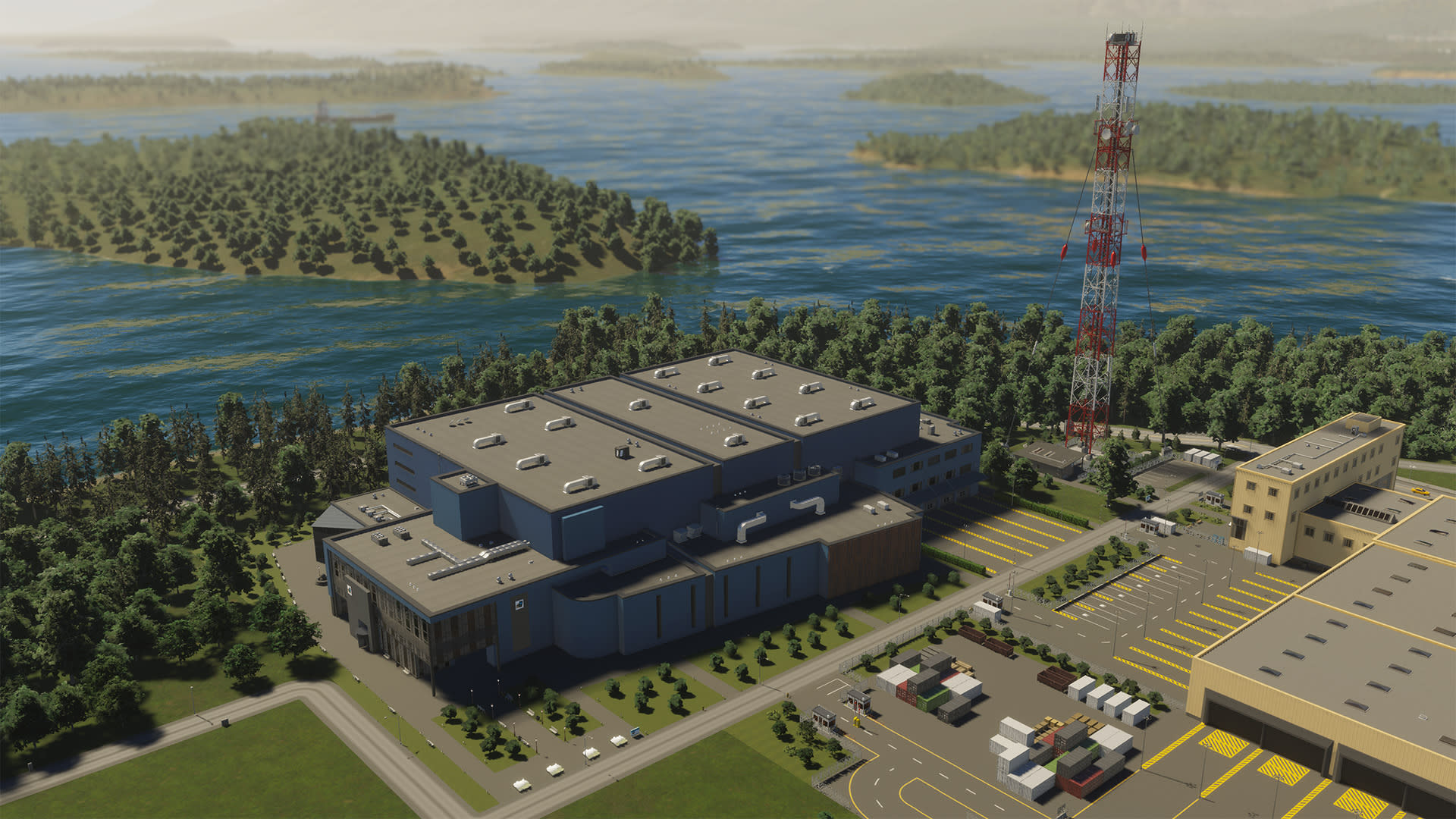
Both the Server Farm (left) and Telecom Tower (right) provide telecom coverage in the city
Landscaping
Landscaping has remained largely the same in Cities: Skylines II. In the Terraforming section, you are able to adjust the terrain to suit your city-building needs by using the familiar tools: Shift Terrain, Level Terrain, Soften Terrain, and Slope Terrain. Landscaping also includes options to plant trees, which have a life cycle in Cities: Skylines II where they grow older and bigger as time goes on. Placing new trees on the map using the tools in Landscaping’s Vegetation menu plants tree saplings that eventually grow into mature trees. Similarly, if a forest fire destroys a part of a forest, it will take time for new trees to grow in place of the old, burned trees.

Terraform the landscape or plant trees from the Landscaping menu Pathways are another familiar feature in the Landscaping menu enabling you to create pavement paths for pedestrians including various styles of pedestrian bridges. As citizens make pathfinding decisions, one of the options to move around in the city is walking. If there are pathways allowing quick access to various parts of the city, then citizens may choose walking over private cars and public transport - the best part is, not only does walking not contribute to traffic congestion but it is free so the citizens have more money to spend elsewhere!

Pedestrian paths provide citizens with shortcuts through terrain or options to bypass roads
Service Upgrades
A new feature in Cities: Skylines II is the city service upgrade system. In the previous game, city services were one-and-done buildings. You placed the building and if the city needed more of the service type, you placed another building of the same type. In Cities: Skylines II each city service building (with few exceptions) is upgradeable, extending its operations to service more citizens and answer different needs of the citizens. Upgrades can add new functionality or expand the existing functionalities of a service building. For example, you can place an ambulance depot or an extension wing to a Medical Clinic to add more ambulances and patient capacity. Similarly, placing an extension wing to an Elementary School increases its student capacity while placing a Children’s Clinic or a Playground improves student Health and Well-being, respectively, both adding new effects to the Elementary School. A power plant can have additional turbines built, increasing the electricity output, an exhaust filter added to decrease the amount of air pollution created by the power plant, or additional storage space for storing fuel. Upgrades come in many forms and improve service buildings in many different ways. It is worth noting that adding upgrades costs money and in most cases, the upgrades also add to the building’s upkeep cost. It may not always be beneficial to build all upgrades for a building but instead to consider the needs of the city and its citizens. Is the exhaust filter necessary for that power plant which is already downwind from the city and the air pollution spreads away from the residential areas? Maybe not. But if the power plant is located near the city center and was built in the early days of the city, the exhaust filter might be exactly what the plant needs. It can continue to operate closer to the city without causing too much harm with its air pollution. If the school is already full of students but more eligible citizens are in the city, is it better to upgrade the school with additional student capacity or build an entirely new school in another part of the city? This depends on where the students are located as providing them with nearby facilities cuts travel time and contributes less to traffic congestion.
Upgrade Types
Service upgrades are divided into three categories: Operational, Extensions, and Sub-buildings. Operational upgrades add functional and statistical changes to the building without changing its looks. These can be bandwidth increases for the Radio Mast, exhaust filters installed in a Coal Power Plant, or a dispatch center built inside the Taxi Depot. Extensions are visible upgrades connected directly to the main building, usually increasing the building's capacity for vehicles, output, range, or the number of citizens being serviced. These include, among other things, extension wings for medical facilities and schools providing more patient and student capacity, respectively, garages for various services increasing the size of their service vehicle fleet and additional turbines for power plants increasing their electricity output and fuel consumption. Extensions have a fixed position on the building lot and fit inside the existing lot size. Sub-buildings are separate buildings attached to the service building’s existing lot. They can increase, for example, the fuel storage capacity of power plants or add new functionality to a building, such as the aforementioned Children’s Clinic and Playground upgrades for the Elementary School. Sub-buildings naturally require additional space to be built so it is important to take into consideration the placement of the service building and make sure that there is enough free space around them for those potential sub-buildings added in the future!
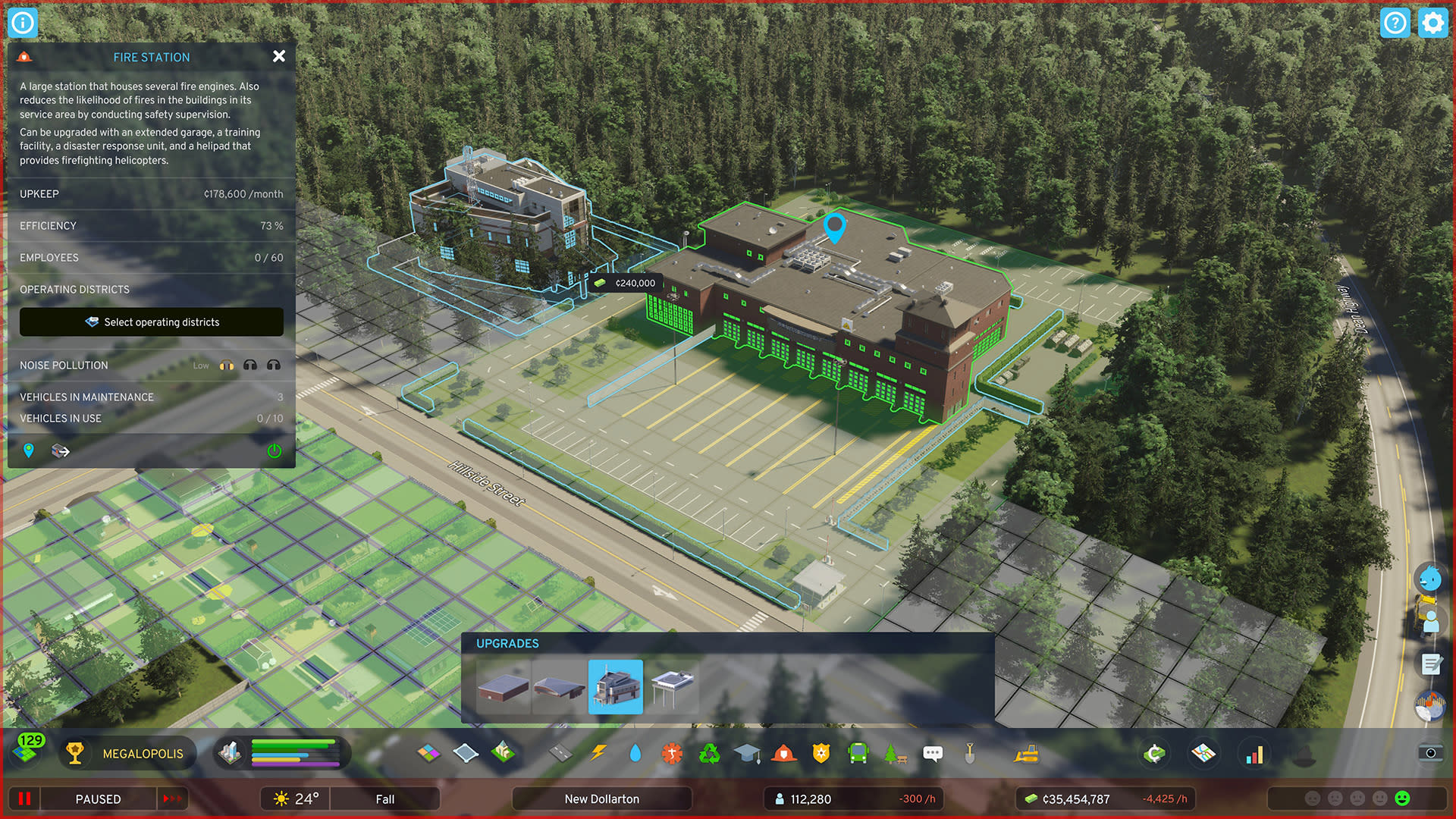
Add a Disaster Response Unit to your Fire Station to search for survivors in collapsed buildings
Service Coverage
In Cities: Skylines II services have both a passive coverage effect and a simulated effect. While the passive effect is local to the area surrounding the building, the simulated effect can reach further into the city through patrolling vehicles or citizens visiting the service building, and often the two work in tandem. As an example, managing the city’s crime rate isn’t about placing a police station on every street corner, instead, the police station’s presence decreases the accumulation of crime in its neighborhood as its passive coverage effect while the patrolling police vehicles extend that reach to all over the city as the simulated effect.
Passive Service Coverage Effect
Many of the city services have a passive effect that spreads to their surroundings along roads. Services with passive effects include:
Healthcare facilities: Health bonus
Education, Elementary Schools: Well-being bonus for families with children
Fire department facilities: Decreased fire hazard
Police department facilities: Decreased crime accumulation
Parks and recreation buildings: Well-being bonus
Welfare Offices: Well-being bonus for citizens whose Happiness is low
The strength of the passive effect depends on three factors: range, capacity, and magnitude. Range is the maximum distance in meters along roads where the service building still provides its passive Service Coverage Effect. Capacity is a rough estimate of how many people the city service building’s passive effect reaches as it travels on the roads, however, the reach of the effect can vary greatly depending on how many people live in its vicinity. If there are only low density housing, the reach can be far, but if the area is densely populated with medium or high density housing, the reach can be quite short as it is used up faster, spreading through the apartment buildings. Magnitude is the maximum effect gained from the passive service coverage. It’s at full effect within most of its range but the effect fades out quickly at the edge - this area is where, as an example, your citizens will only have a few bars on their cellphones and their internet may be unreliable, making some overlap of passive service coverage worth it if you are aiming for the best coverage.
Service Efficiency
In Cities: Skylines II one of the most important aspects of both businesses and city services is their Efficiency value, which represents how well the building performs its function. In the case of city services, Efficiency affects the buildings’ capacity, processing speed, or output, depending on whichever value or values are the most relevant for the city service, and it may also have an effect on the range of passive service coverage effects and city-wide effects of certain service buildings. Below are the functions affected by Efficiency for each service type:
Roads: Number of available road maintenance vehicles
Electricity: Electricity output level
Water & Sewage: Water output level, sewage processing speed
Healthcare & Deathcare: Treatment bonus, processing speed of the deceased, number of available ambulances and hearses
Garbage Management: Garbage processing speed, number of available garbage trucks
Education & Research: Graduation bonus
Fire & Rescue: Number of available fire engines
Police & Administration: Number of available police cars
Transportation: Number of available transportation vehicles
Parks & Recreation: Attractiveness value, number of available park maintenance vehicles
Communication: Number of available post vehicles, network range, and capacity
Calculating Efficiency
Many factors contribute to a building’s Efficiency, some are essential for the building to even work while others are important but lacking some doesn’t entirely halt the building’s functionality. Water and electricity are the basic needs for a building to function, and lacking either one of them incurs a large Efficiency penalty while lacking both leads to the building becoming inoperative. Employees are an important factor when it comes to building Efficiency as having the right amount of employees who are happy, healthy, and have the right Education levels, ensures that the buildings function as smoothly as possible. Employee Happiness gives a boost to Efficiency while unhappy employees incur a penalty. If employees become sick, they can’t contribute to their workplace’s Efficiency which incurs a penalty. And the inability to find employees who are suitably educated will also have a negative impact on the building’s Efficiency. As a reminder, highly educated employees are able to fill job positions requiring lower education levels but it is impossible for a lower educated employee to fill a higher education level position.
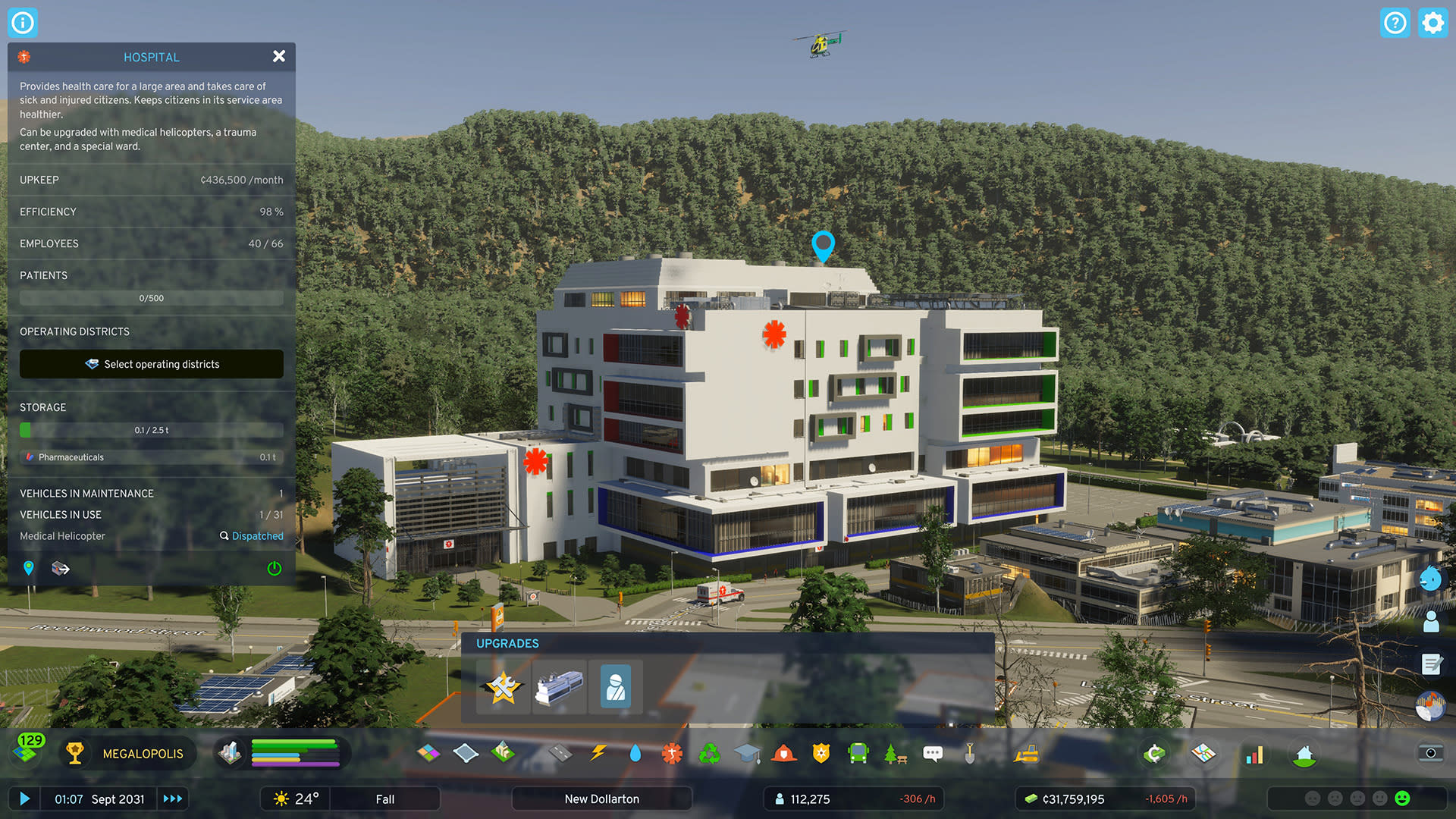
Happy employees of the right education levels increase efficiency but make sure your services don’t run out of resources Some service buildings, such as many power plants, use fuel or other resources to function. As an example, if a power plant does not have access to fuel for any reason, its Efficiency decreases greatly. In the case of power plants, the resource can also be immaterial such as wind and sun. A Wind Turbine loses most of its Efficiency if there is not enough wind available for it to produce electricity, and similarly, during night time, the Solar Power Plant does not produce electricity and instead relies on built-in batteries to keep the lights on in the city. Medical facilities are another example of a service dependent on a resource as they use pharmaceuticals (a type of produced goods) while treating patients. If the building runs out of this resource, its Efficiency decreases and as a result, the treatment bonus added to the citizens’ recovery decreases. Lastly, the City service budget can be used to affect the Efficiency of all buildings within a service category. Perhaps your city is still small and it doesn’t require the full force of the service to function in which case lowering the budget can be useful as it lowers the Efficiency, decreases the upkeep costs, and cuts down on the service’s vehicle use or other functionality. Or maybe your city is growing rapidly but you are not ready to invest in additional service buildings just yet. In that case, increasing the service budget will increase the Efficiency of all the service buildings allowing them to service more citizens.
Service Fees
In the Economy panel, you will find a page dedicated to city services and adjusting their budget. The budget slider affects all of the service’s buildings equally and its main function is to reduce and increase the upkeep cost and affect the buildings’ Efficiency. Expenses displayed on the panel comprise of maintenance (also known as building upkeep), and depending on the city service, resource costs such as fuel for power plants. The panel also includes service import and export information as well as the fees collected from city services that have them. Yes, that’s right, some services collect fees from the citizens. These include Roads, Electricity, Water & Sewage, Healthcare, Garbage Management, Education, and Transportation services. Electricity and water fees are paid by citizens and companies alike, and the fees can be adjusted in the Economy panel. Lowering the fees increases citizen Happiness and company profitability but also increases the usage of water and electricity. Increasing the fee decreases citizen Happiness and company profitability but also decreases the usage of water and electricity. Using these fees, on their own or in addition to District policies, you can encourage citizens to conserve electricity, decreasing the demand in the city.
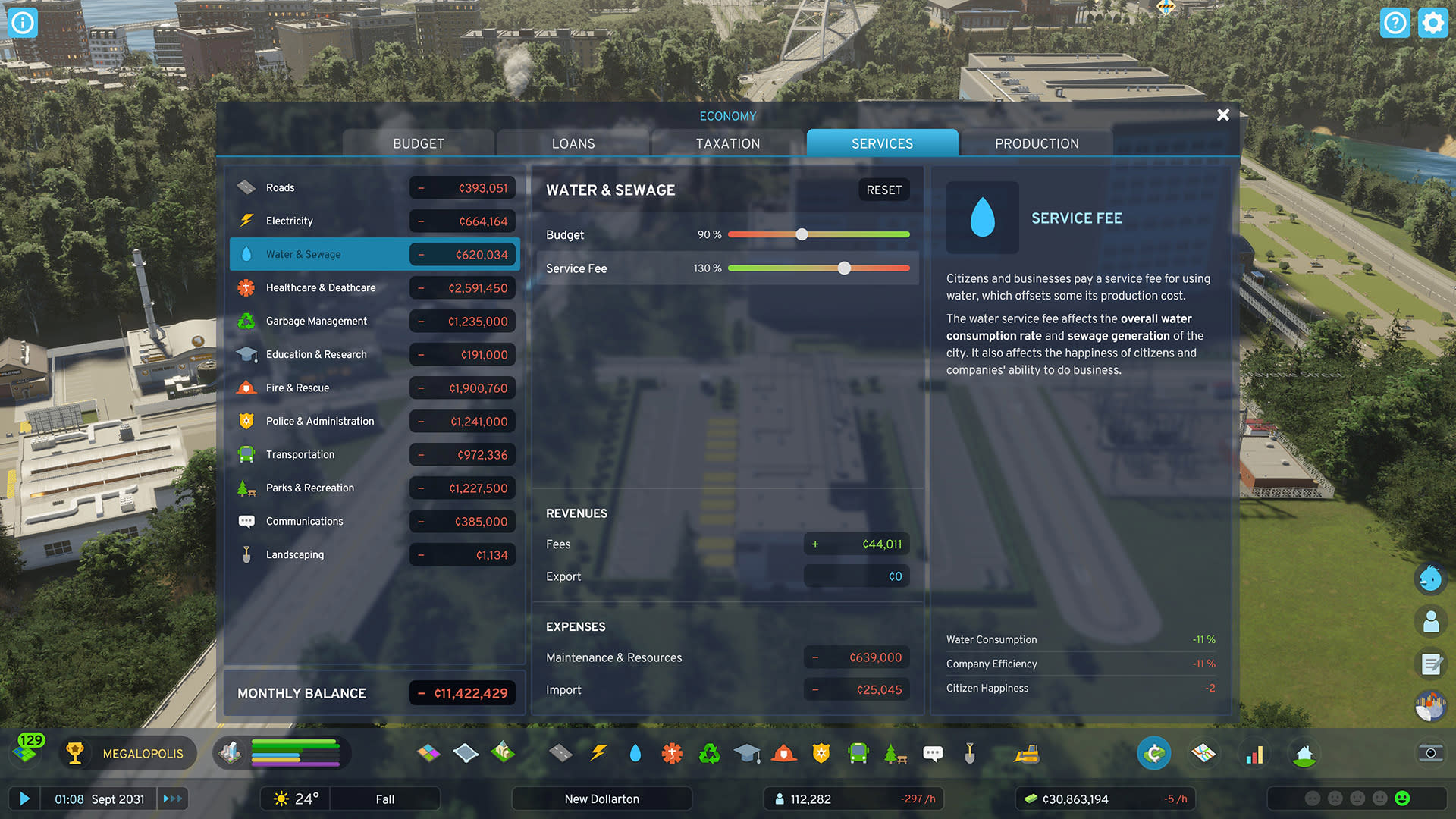
Adjust both the service budget and related fees in the Economy panel Citizens also pay a fee for Healthcare services when they visit medical facilities to get treatment, while Garbage fees are paid when garbage trucks collect garbage from households and companies. Additionally, Citizens pay for education, with each school type having its own service fee, the cheapest being the Elementary School and the most expensive being the University. You can set up roadside parking fees for Districts and the various parking lots and parking halls included in the Roads service. Similarly, each passenger transportation line’s ticket fee can be adjusted individually, which can encourage or discourage citizens to use certain methods of transportation as the cost is considered when they make pathfinding decisions.
Service Trade
Whether your city is just starting out and you can’t afford to build a service or whether it’s thriving with excess to spare, it can benefit from service trade. Services can be imported from or exported to neighboring cities through Outside Connections and apply to most services. You can save money by not building a service, but of course, imported services also cost money and it takes time for the service vehicles to arrive from one of the Outside Connections. On the other hand, exporting services can be beneficial to a large and established city selling any excess to neighboring cities. Electricity, water, and sewage services can all be imported and exported. Electricity is transferred from Outside Connections through power lines and into a Transformer Station or vice versa. From there it is distributed to the local grid, ready to be used. You can find power lines running through the map making it possible to connect to your neighbors when you are first starting out. Clean water can be delivered to the city or pumped to neighboring cities via pipe Outside Connections, and likewise, sewage can be sent to and from Outside Connections via pipes built to the edge of the city. To import or export both water and sewage you will need to grow your city enough to reach the edges of the map, where you can create pipe Outside Connections. Excess output is always sold, if possible, while keeping enough for the city’s own needs, and if the usage increases, less is sold to Outside Connections.
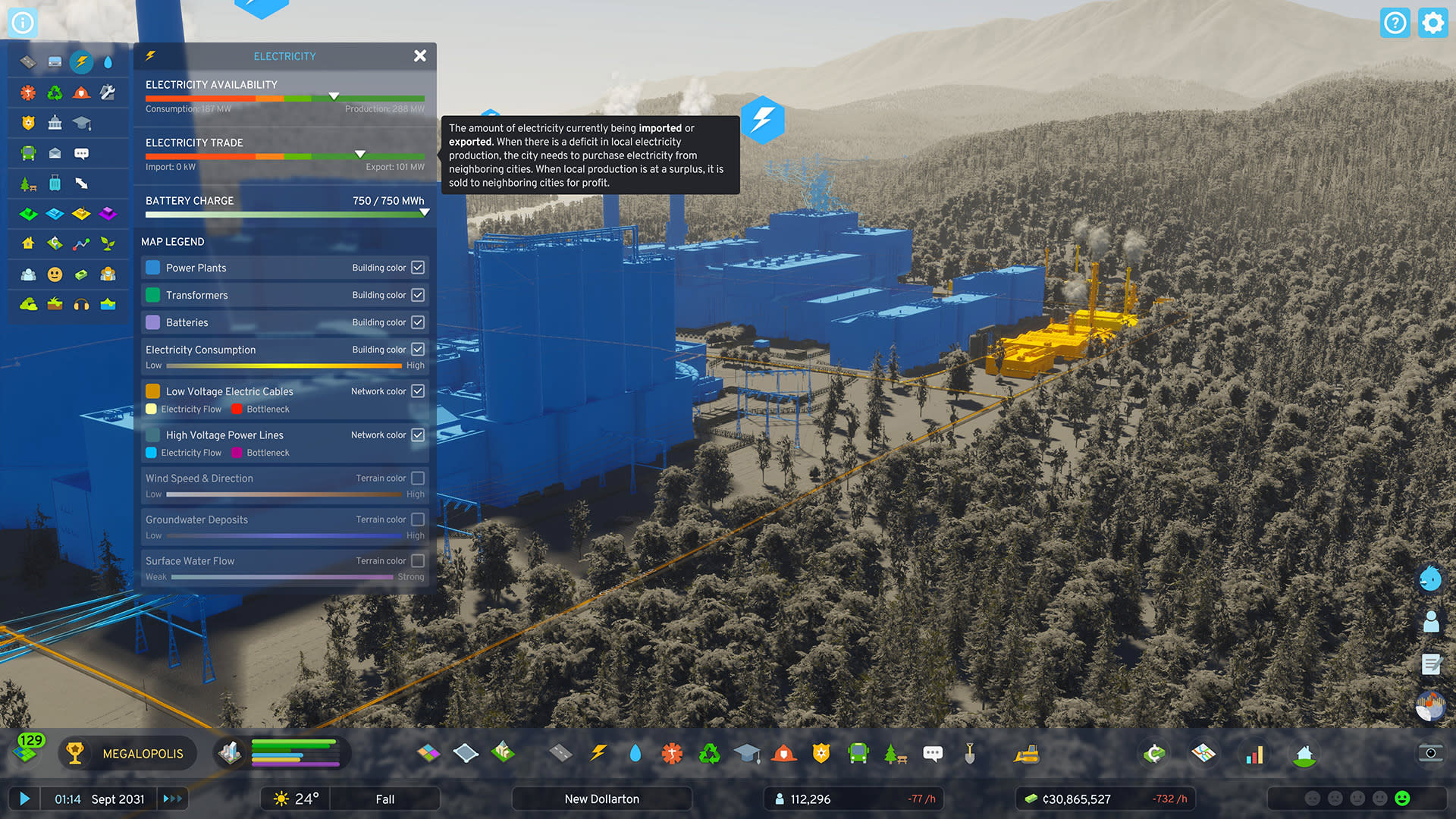
Import electricity when your usage increases or export any excess you might produce If the city does not have any medical facilities, citizens travel to Outside Connections to get treated. If they are too sick or injured to travel, an ambulance is sent from an Outside Connection to pick them up. Once they are treated, they travel back to the city. Similarly, if the city lacks proper deathcare facilities, hearses arrive from Outside Connections to pick up the deceased and transport them out of the city. Police and fire services can be imported, although their response times are slow as they arrive at crime scenes and emergencies from Outside Connections. Also, the imported services lack the passive service coverage effects from their respective service buildings, which can otherwise decrease crime and fire hazards respectively. Citizens wanting to go to College or University may travel to Outside Connections if the schools are not available in the city. However, traveling outside of the city for Education may also encourage them to actually move out of the city for good. Therefore it is important to offer the citizens the education options they need! Likewise, your city can export education and attract students from Outside Connections who want to study at the city’s Colleges and Universities. These students move into the city to study and in the process, they also become fully-fledged citizens once they find a home.
Districts & Policies
Districts give you more in-depth information about the populace residing there, while policies can be applied to individual districts or city-wide bringing flavor and fine-tuning to different areas of the city. The District Panel shows information about how many citizens live there, their average wealth level and what are their Education levels, as well as which policies are enabled for the district. Hovering over the Happiness for the district will show you all the benefits and drawbacks of the area, giving you an idea of how you can improve that part of the city. Creating a district is quite straightforward. With the District Tool, you define an area by placing corner nodes and once you “close” the area, the district is created. This method is faster and more precise than in the game’s predecessor, and the district can be adjusted after it’s created by moving the nodes or adding new nodes to the edges. It’s named automatically but you are able to rename it after its creation to suit your city.
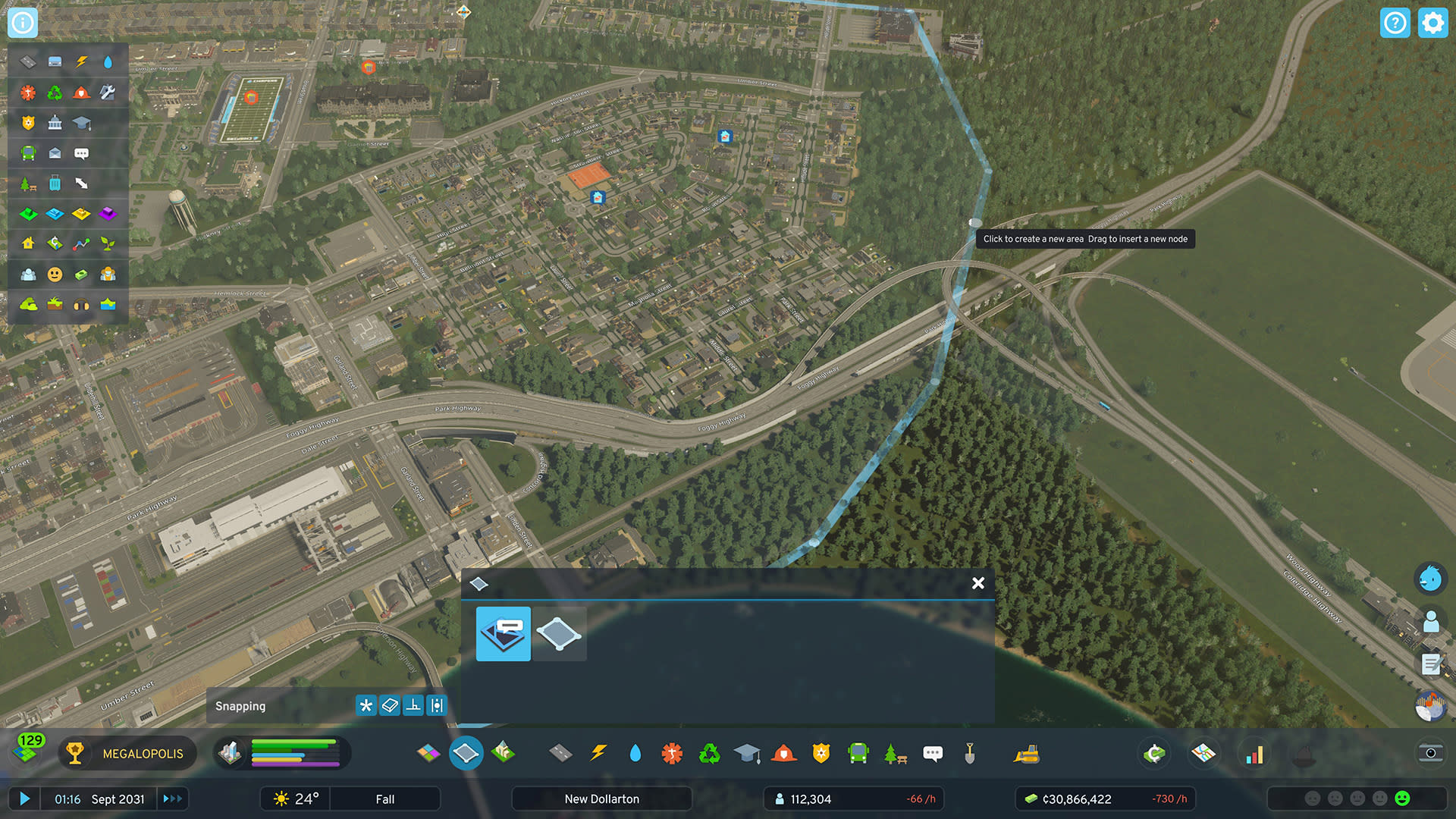
Districts can be renamed and adjusted after their creation City services can be assigned to one or more districts limiting their services to only those areas of the city. Services that have not been assigned to any districts will service the entire city, regardless of district borders. It is important to note that even though a service building is assigned to multiple districts, its passive service coverage effect still applies only to its neighborhood. Only its simulated service effects i.e. its vehicles travel to all of the assigned districts. District policies bring more city-planning control over specific districts. For example, you can limit heavy traffic in a district to decrease traffic-based noise and air pollution which in turn increases citizens’ Well-being and Health. Installing speed bumps slows down traffic, decreasing noise pollution and the likelihood of traffic accidents, while setting up a gated community denies access to the district from all outsiders except for delivery trucks and service vehicles. Roadside parking fee can bring some income from the district but it also affects citizen pathfinding as they now calculate whether it is cheaper to use other modes of transportation than their own vehicle if they have to pay for parking as well!
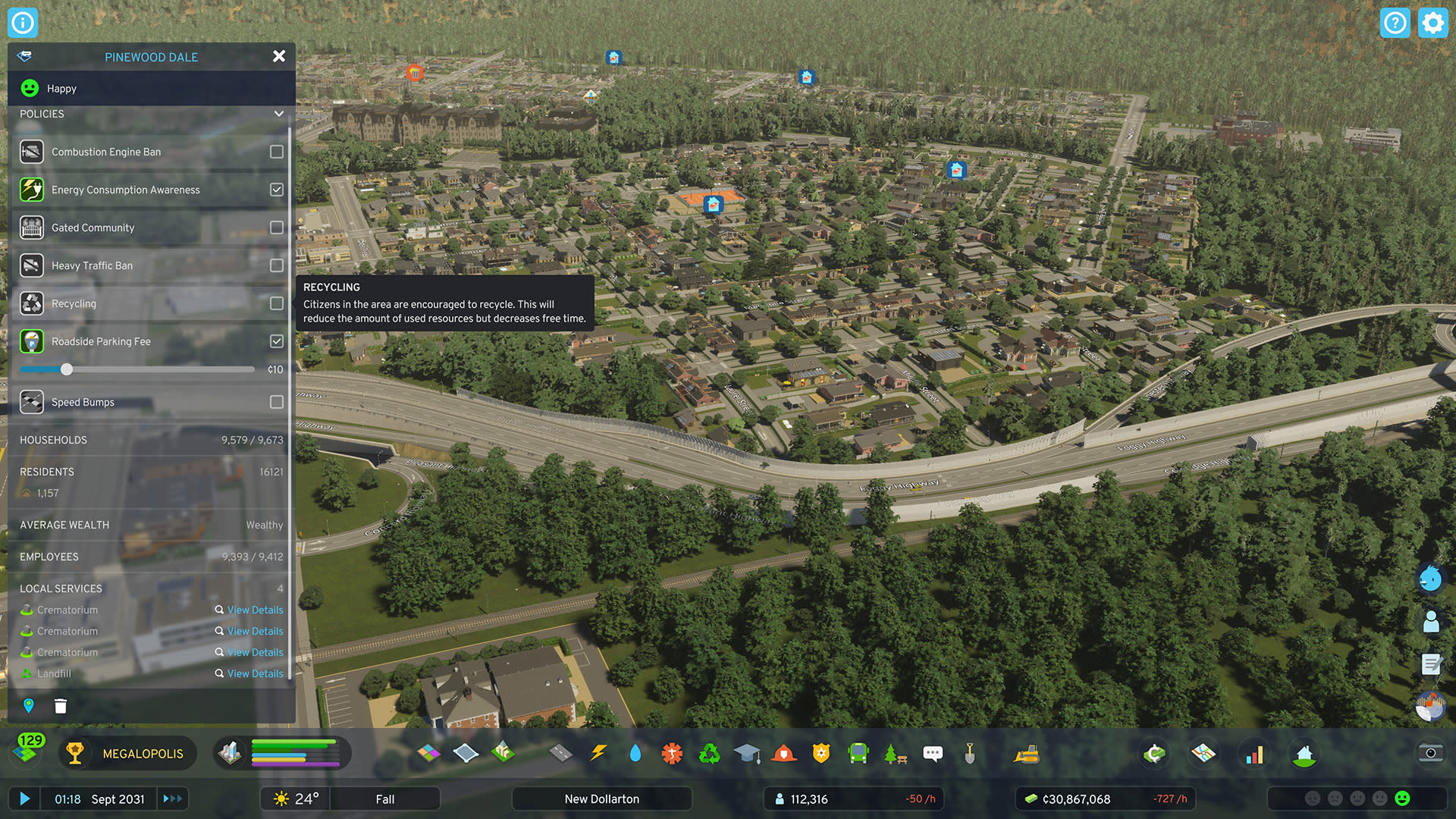
Enable specific district policies to customize areas of your city City policies are different from district policies and have city-wide effects such as removing the speed limits from highways or installing air filters for manufacturing companies in industrial zones to limit air pollution. Some policies have a cost or negative consequence linked to them while others are more neutral. Taking our example of highways with no speed limits, this policy can make traffic flow faster but it also increases the likelihood of traffic accidents. Installing air filters decrease air pollution but those filters need cleaning every now and increase the amount of garbage these factories produce.

City policies apply to your entire city and are found in the City Information panel Cities: Skylines II includes 7 different district policies and 5 city policies providing different ways to customize your city. District policies are applied by selecting the district and choosing the policies you want to apply, while the city policies can be found in the City Information panel. That’s all we have for you today, we hope this has brought you insight into how services work in Cities: Skylines II, what’s new, and what’s familiar to the predecessor. Are you looking forward to being able to upgrade your service buildings? Or perhaps taking advantage of the option to import or export services? Let us know in the comments. Next week we dive into more details about the Electricity and Water services in Cities: Skylines II so you have all the information you need to provide your citizens with these basic utilities.
